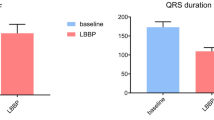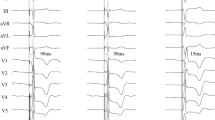Abstract
Purpose
His bundle pacing (HBP) improves heart failure (HF) in atrial fibrillation (AF) pacing–dependent patients with a potential for a progressively increased threshold. HBP with right ventricular pacing (RVP) as a backup is always the preferred choice; however, RVP may induce HF. His Purkinje system pacing (HPSP) includes HBP and left bundle branch area pacing (LBBAP). LBBAP maintains left ventricular synchrony but has not been proven to be safe over the long term. We assessed the feasibility and safety of both HBP and LBBAP in AF pacing–dependent patients and compared the parameters of both leads at baseline and at the 6-month follow-up.
Methods
A total of 16 AF patients in our center, who successfully attempted both HBP and LBBAP, were prospectively enrolled unless only one of these treatment statuses was attained. The electrocardiogram characteristics, leading parameters, echocardiography results, and clinical outcomes were assessed.
Results
Thirteen out of 16 patients achieved both HBP and LBBAP successfully in the same AF pacing–dependent patients. In symptomatic HF patients with preserved left ventricular ejection fraction (LVEF) (n = 10), the left ventricular end-diastolic diameter (LVEDD) was reduced from 51.8 ± 4.4 to 48.3 ± 3.1 mm (p = 0.01) with the use of diuretics, either reduced or stopped (n = 7). During the follow-up, one patient in the group without HF had an increased HBP threshold and developed HF symptoms. His HF symptoms disappeared when switched into LBBAP mode. Another patient in the group with HF got his LVEF elevated by HBP for 3 months by utilizing left bundle branch block(LBBB)correction and continued to increase when switched into LBBAP for another 3 months due to an increased HBP correction threshold. The average unipolar pacing threshold of LBBAP was lower than that of HBP. No perforation or dislodgement occurred in our study.
Conclusion
Both HBP and LBBAP could be attempted successfully in the same AF patients when one of the two modes could be adopted and switched according to the clinical feasibility. Compared with HBP, LBBAP yielded better and more stable parameters but showed comparable effects during the 6-month follow-up.




Similar content being viewed by others
References
Kaye GC, Linker NJ, Marwick TH, Pollock L, Graham L, Pouliot E, et al. Effect of right ventricular pacing lead site on left ventricular function in patients with high-grade atrioventricular block: results of the Protect-Pace study. Eur Heart J. 2015;36(14):856–62. https://doi.org/10.1093/eurheartj/ehu304.
Zhang XH, Chen H, Siu CW, Yiu KH, Chan WS, Lee KL, et al. New-onset heart failure after permanent right ventricular apical pacing in patients with acquired high-grade atrioventricular block and normal left ventricular function. J Cardiovasc Electrophysiol. 2008;19(2):136–41. https://doi.org/10.1111/j.1540-8167.2007.01014.x.
Deshmukh P, Casavant DA, Romanyshyn M, Anderson K. Permanent, direct His-bundle pacing: a novel approach to cardiac pacing in patients with normal His-Purkinje activation. Circulation. 2000;101(8):869–77.
Slotwiner DJ, Raitt MH, Del-Carpio Munoz F, Mulpuru SK, Nasser N, Peterson PN. Impact of physiologic pacing versus right ventricular pacing among patients with left ventricular ejection fraction greater than 35%: a systematic review for the 2018 ACC/AHA/HRS Guideline on the Evaluation and Management of Patients With Bradycardia and Cardiac Conduction Delay: A Report of the American College of Cardiology/American Heart Association Task Force on Clinical Practice Guidelines and the Heart Rhythm Society. J Am Coll Cardiol. 2019;74(7):988–1008. https://doi.org/10.1016/j.jacc.2018.10.045.
Ye Y, Zhang Z, Sheng X, Wang B, Chen S, Pan Y, et al. Upgrade to his bundle pacing in pacing-dependent patients referred for pulse generator change: feasibility and intermediate term follow up. Int J Cardiol. 2018;260:88–92. https://doi.org/10.1016/j.ijcard.2018.01.105.
Abdelrahman M, Subzposh FA, Beer D, Durr B, Naperkowski A, Sun H, et al. Clinical outcomes of his bundle pacing compared to right ventricular pacing. J Am Coll Cardiol. 2018;71(20):2319–30. https://doi.org/10.1016/j.jacc.2018.02.048.
Vijayaraman P, Subzposh FA, Naperkowski A. Atrioventricular node ablation and His bundle pacing. Europace. 2017;19(suppl_4):iv10–iv6. https://doi.org/10.1093/europace/eux263.
Kaye G, Ng JY, Ahmed S, Valencia D, Harrop D, Ng ACT. The prevalence of pacing-induced cardiomyopathy (PICM) in patients with long term right ventricular pacing - is it a matter of definition? Heart Lung Circ. 2019;28(7):1027–33. https://doi.org/10.1016/j.hlc.2018.05.196.
Huang W, Su L, Wu S, Xu L, **ao F, Zhou X, et al. Long-term outcomes of His bundle pacing in patients with heart failure with left bundle branch block. Heart. 2019;105(2):137–43. https://doi.org/10.1136/heartjnl-2018-313415.
Huang W, Su L, Wu S, Xu L, **ao F, Zhou X, et al. Benefits of permanent His bundle pacing combined with atrioventricular node ablation in atrial fibrillation patients with heart failure with both preserved and reduced left ventricular ejection fraction. J Am Heart Assoc. 2017;6(4). https://doi.org/10.1161/JAHA.116.005309.
Cai B, Huang X, Li L, Guo J, Chen S, Meng F, et al. Evaluation of cardiac synchrony in left bundle branch pacing: insights from echocardiographic research. J Cardiovasc Electrophysiol. 2020;31(2):560–9. https://doi.org/10.1111/jce.14342.
Hou X, Qian Z, Wang Y, Qiu Y, Chen X, Jiang H, et al. Feasibility and cardiac synchrony of permanent left bundle branch pacing through the interventricular septum. Europace. 2019;21(11):1694–702. https://doi.org/10.1093/europace/euz188.
Chen K, Li Y, Dai Y, Sun Q, Luo B, Li C, et al. Comparison of electrocardiogram characteristics and pacing parameters between left bundle branch pacing and right ventricular pacing in patients receiving pacemaker therapy. Europace. 2019;21(4):673–80. https://doi.org/10.1093/europace/euy252.
Huang W, Su L, Wu S, Xu L, **ao F, Zhou X, et al. A novel pacing strategy with low and stable output: pacing the left bundle branch immediately beyond the conduction block. Can J Cardiol. 2017;33(12):1736 e1–3. https://doi.org/10.1016/j.cjca.2017.09.013.
Huang W, Chen X, Su L, Wu S, **a X, Vijayaraman P. A beginner's guide to permanent left bundle branch pacing. Heart Rhythm. 2019;16(12):1791–6. https://doi.org/10.1016/j.hrthm.2019.06.016.
Vijayaraman P, Herweg B, Dandamudi G, Mittal S, Bhatt AG, Marcantoni L, et al. Outcomes of His-bundle pacing upgrade after long-term right ventricular pacing and/or pacing-induced cardiomyopathy: insights into disease progression. Heart Rhythm. 2019;16(10):1554–61. https://doi.org/10.1016/j.hrthm.2019.03.026.
Yamasaki N, Kondo F, Kubo T, Okawa M, Matsumura Y, Kitaoka H, et al. Severe tricuspid regurgitation in the aged: atrial remodeling associated with long-standing atrial fibrillation. J Cardiol. 2006;48(6):315–23.
Chen X, Wu S, Su L, Su Y, Huang W. The characteristics of the electrocardiogram and the intracardiac electrogram in left bundle branch pacing. J Cardiovasc Electrophysiol. 2019;30(7):1096–101. https://doi.org/10.1111/jce.13956.
Vijayaraman P, Dandamudi G, Lustgarten D, Ellenbogen KA. Permanent His bundle pacing: electrophysiological and echocardiographic observations from long-term follow-up. Pacing Clin Electrophysiol. 2017;40(7):883–91. https://doi.org/10.1111/pace.13130.
Wang S, Wu S, Xu L, **ao F, Whinnett ZI, Vijayaraman P, et al. Feasibility and efficacy of His bundle pacing or left bundle pacing combined with atrioventricular node ablation in patients with persistent atrial fibrillation and implantable cardioverter-defibrillator therapy. J Am Heart Assoc. 2019;8(24):e014253. https://doi.org/10.1161/JAHA.119.014253.
Huang W, Wu S, Vijayaraman P, Su L, Chen X, Cai B, et al. Cardiac resynchronization therapy in patients with nonischemic cardiomyopathy using left bundle branch pacing. JACC Clin Electrophysiol. 2020;6(7):849–58. https://doi.org/10.1016/j.jacep.2020.04.011.
Upadhyay GA, Cherian T, Shatz DY, Beaser AD, Aziz Z, Ozcan C, et al. Intracardiac delineation of septal conduction in left bundle-branch block patterns. Circulation. 2019;139(16):1876–88. https://doi.org/10.1161/CIRCULATIONAHA.118.038648.
Auricchio A, Fantoni C, Regoli F, Carbucicchio C, Goette A, Geller C, et al. Characterization of left ventricular activation in patients with heart failure and left bundle-branch block. Circulation. 2004;109(9):1133–9. https://doi.org/10.1161/01.CIR.0000118502.91105.F6.
Vijayaraman P, Subzposh FA, Naperkowski A, Panikkath R, John K, Mascarenhas V, et al. Prospective evaluation of feasibility, electrophysiologic and echocardiographic characteristics of left bundle branch area pacing. Heart Rhythm. 2019;16:1774–82. https://doi.org/10.1016/j.hrthm.2019.05.011.
Su L, Xu T, Cai M, Xu L, Vijayaraman P, Sharma PS, et al. Electrophysiological characteristics and clinical values of left bundle branch current of injury in left bundle branch pacing. J Cardiovasc Electrophysiol. 2020;31(4):834–42. https://doi.org/10.1111/jce.14377.
Salden F, Luermans J, Westra SW, Weijs B, Engels EB, Heckman LIB, et al. Short-term hemodynamic and electrophysiological effects of cardiac resynchronization by left ventricular septal pacing. J Am Coll Cardiol. 2020;75(4):347–59. https://doi.org/10.1016/j.jacc.2019.11.040.
Acknowledgements
We thank Weijian Huang, MD, PhD, for sharing his experience in His bundle pacing and left bundle area pacing with us. We thank Dr. Derek from UK for his help in English writing, editing, and thoughtful review of the manuscript. We would like to thank anonymous reviewers for comments on earlier drafts.
Funding
This work was supported by the funding from Clinical research project of Zhejiang Medical Association (no. 2016ZYC-A28).
Author information
Authors and Affiliations
Corresponding author
Ethics declarations
Conflict of interests
The authors declare that they have no conflict of interest.
Additional information
Publisher’s note
Springer Nature remains neutral with regard to jurisdictional claims in published maps and institutional affiliations.
Rights and permissions
About this article
Cite this article
Ye, Y., Zhang, K., Yang, Y. et al. Feasibility and safety of both His bundle pacing and left bundle branch area pacing in atrial fibrillation patients: intermediate term follow-up. J Interv Card Electrophysiol 66, 271–280 (2023). https://doi.org/10.1007/s10840-021-00964-6
Received:
Accepted:
Published:
Issue Date:
DOI: https://doi.org/10.1007/s10840-021-00964-6




